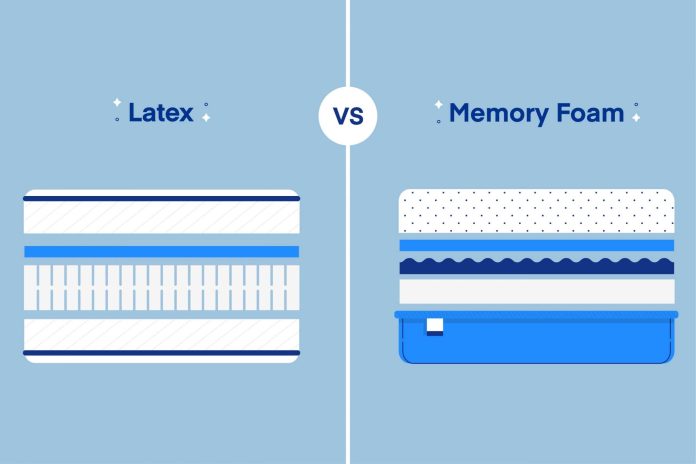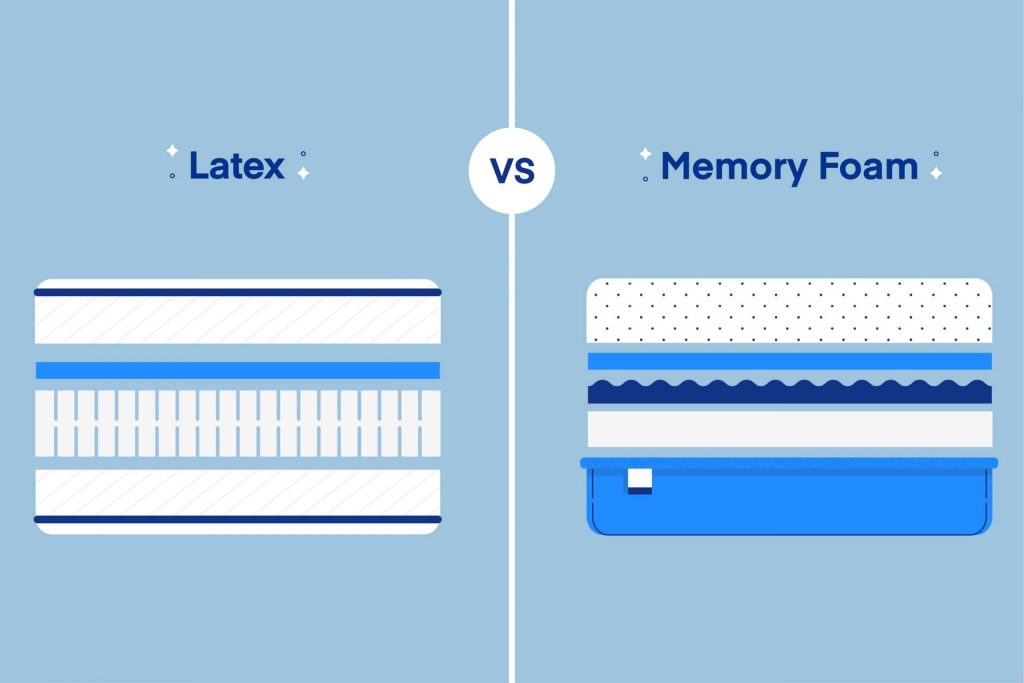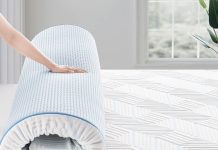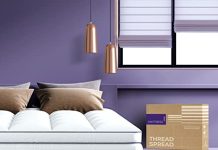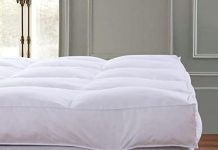Curious about the different types of mattresses available? Look no further! In this article, we’re here to shed some light on the differences between memory foam, latex, and innerspring mattresses. Whether you’re seeking ultimate comfort, optimal support, or a balance of both, we’ve got you covered. Let’s find out which mattress type suits your needs and ensures a good night’s sleep!
Review contents
Memory Foam Mattresses
Definition and Composition
Memory foam mattresses are known for their ability to conform to the body’s shape and provide customized support. These mattresses are made from a viscoelastic polyurethane foam that is designed to respond to the body’s heat and weight. The foam contours to the curves of the body, evenly distributing the weight and relieving pressure points.
Pressure Relief and Support
One of the major advantages of memory foam mattresses is their ability to provide excellent pressure relief. The foam molds to the body, reducing pressure on points like shoulders, hips, and knees. This feature makes memory foam mattresses particularly suitable for individuals with chronic pain or joint issues. Additionally, memory foam mattresses provide support by evenly distributing body weight, promoting proper spinal alignment, and reducing the risk of developing back or neck pain.
Heat Retention
While memory foam mattresses are praised for their pressure relief and support, they are also known for their tendency to retain heat. The dense nature of the foam can trap body heat, causing some sleepers to feel uncomfortably warm. However, advancements in mattress technology have led to the development of cooling gel-infused memory foam mattresses that regulate temperature and promote a cooler sleep environment.
Durability
Memory foam mattresses are generally durable and can last for many years. The quality of the foam and the density are important factors in determining the longevity of a memory foam mattress. Higher density foam tends to be more durable and less likely to sag or develop indentations over time. It’s important to choose a memory foam mattress with a reputable brand and warranty to ensure its longevity.
Motion Transfer
One of the significant advantages of memory foam mattresses is their ability to minimize motion transfer. This means that when one person moves or gets out of bed, their movements are less likely to disturb their sleeping partner. The foam absorbs and isolates motion, allowing for a more undisturbed sleep experience.
Price Range
The price range of memory foam mattresses can vary depending on factors such as the quality of materials, brand reputation, and mattress thickness. On average, memory foam mattresses tend to be more affordable than latex mattresses and comparable to innerspring mattresses. However, there are luxury memory foam options available at higher price points for those seeking premium features and materials.
Maintenance
Maintaining a memory foam mattress is relatively easy. Regularly rotating the mattress will help prevent uneven wear and sagging. Spot-cleaning any stains with mild detergent and warm water is recommended. Additionally, using a mattress protector can help prevent spills, stains, and the buildup of dust mites.
Suitability for Different Sleeping Positions
Memory foam mattresses are versatile and can accommodate various sleeping positions. The conforming nature of the foam allows it to provide adequate support and pressure relief for side sleepers by cushioning the hips and shoulders. Back sleepers can benefit from the foam’s ability to maintain spinal alignment. However, some stomach sleepers may find memory foam mattresses too soft and prefer a firmer surface to prevent excessive sinking of the abdomen.
Hypoallergenic Properties
Memory foam mattresses are naturally hypoallergenic, as the dense foam discourages the accumulation of dust mites, pet dander, and other allergens. This feature makes memory foam mattresses a suitable choice for individuals with respiratory conditions or allergies.
Odor and Off-Gassing
New memory foam mattresses often have a distinct odor, commonly referred to as off-gassing. This odor is caused by the release of volatile organic compounds (VOCs) during the manufacturing process. However, the odor typically dissipates within a few days or weeks after unpacking the mattress. To expedite the off-gassing process, it is recommended to allow the mattress to air out in a well-ventilated room.
This image is property of amerisleep.com.
Latex Mattresses
Definition and Composition
Latex mattresses are made from natural or synthetic latex, which is derived from the sap of rubber trees. Natural latex is the preferred choice for those seeking an eco-friendly option, as it is biodegradable and sourced from sustainable plantations. Synthetic latex, on the other hand, is made from petroleum-based materials.
Pressure Relief and Support
Latex mattresses offer excellent pressure relief and support, comparable to memory foam mattresses. The natural elasticity of latex allows it to conform to the body’s contours, reducing pressure on key areas. Latex mattresses provide a buoyant feel, offering just the right amount of support and preventing excessive sinking. The responsiveness of latex ensures proper spinal alignment, making it ideal for individuals with back pain.
Heat Regulation
Latex mattresses have a natural ability to regulate temperature, making them an appealing option for individuals who tend to sleep hot. The open-cell structure of latex allows for superior airflow, dissipating body heat and promoting a cooler sleep environment. Unlike memory foam, latex does not retain heat, keeping sleepers cool and comfortable throughout the night.
Durability
Latex mattresses are known for their exceptional durability. The natural resilience of latex allows the mattress to maintain its shape and support over time. Latex mattresses can last for many years without significant sagging or loss of comfort. Opting for a higher-quality latex mattress ensures maximum longevity and performance.
Motion Transfer
While latex mattresses provide excellent support and pressure relief, they may not perform as well in terms of motion isolation. Due to the bounciness and responsive nature of latex, movements on one side of the mattress can cause slight disturbances on the other side. However, many latex mattresses come with specialized features, such as individually wrapped coils or motion-isolating layers, to minimize this issue.
Price Range
Latex mattresses tend to be more expensive than memory foam mattresses and most innerspring mattresses. The price variation depends on factors such as the type of latex (natural or synthetic), mattress thickness, and additional features. Natural latex mattresses command a higher price tag due to their eco-friendly properties and sustainable sourcing.
Maintenance
Maintaining a latex mattress is relatively simple. Regularly rotating the mattress helps distribute the wear evenly and prolongs its lifespan. Spot-cleaning any stains using a mild detergent and warm water is recommended. Utilizing a mattress protector adds an extra layer of protection against spills, allergens, and dust mites.
Suitability for Different Sleeping Positions
Latex mattresses are suitable for various sleeping positions, offering a balance of comfort and support. Side sleepers can benefit from the pressure-relieving properties of latex, especially if the mattress has a plush surface. Back sleepers will appreciate the latex’s ability to maintain spinal alignment. Stomach sleepers may find latex mattresses more suitable if they prefer a firmer surface to prevent excessive sinking of the abdomen.
Hypoallergenic Properties
Latex mattresses are naturally resistant to dust mites, mold, and mildew. This hypoallergenic nature makes them an excellent choice for individuals with allergies or asthma. Natural latex is particularly sought after for its antimicrobial properties and resistance to dust mites, making it a healthier sleep surface overall.
Latex Allergies
Although rare, some individuals may have latex allergies. In such cases, it is essential to opt for a mattress made from synthetic latex or alternative materials. Synthetic latex does not contain the proteins that cause allergic reactions, making it a suitable option for people with latex sensitivities.
This image is property of sleepopolis.com.
Innerspring Mattresses
Definition and Composition
Innerspring mattresses, also known as coil mattresses, are built with a core support system consisting of metal coils or springs. The coils are typically made from steel and provide the primary support for the mattress. Additional layers of upholstery, such as foam or fiber padding, are added for comfort and cushioning.
Pressure Relief and Support
Innerspring mattresses offer varying levels of pressure relief and support, depending on the design and materials used. A higher coil count generally indicates better support and may alleviate pressure on key areas. However, unlike memory foam or latex, innerspring mattresses may not conform as closely to the body’s contours, potentially causing pressure points and discomfort for some sleepers. Choosing a model with additional comfort layers can enhance pressure relief.
Motion Transfer
Innerspring mattresses tend to have less motion isolation compared to memory foam or latex mattresses. The coils or springs transfer motion easily, meaning that movements on one side of the mattress can be felt on the other side. For couples or individuals who are easily disturbed by movement during sleep, opting for an innerspring mattress with pocketed coils or individually wrapped springs can help minimize motion transfer.
Durability
The durability of an innerspring mattress depends on factors such as coil quality, wire gauge, and overall construction. Higher coil counts, thicker wire gauge, and stronger materials generally contribute to a more durable mattress. It’s important to check for a solid warranty from the manufacturer, as this can provide assurance of the mattress’s longevity.
Heat Regulation
Innerspring mattresses excel in heat dissipation due to their open design. The airflow between the coils allows heat to escape, preventing heat retention and helping sleepers stay cooler throughout the night. This feature makes innerspring mattresses an excellent choice for individuals who sleep hot or reside in warmer climates.
Price Range
Innerspring mattresses are available in a wide price range to accommodate different budgets. The price variation is influenced by factors such as coil count, coil type (bonnell, continuous, offset, or pocketed), wire gauge, and additional features. Generally, innerspring mattresses are more affordable compared to memory foam or latex mattresses.
Maintenance
Maintaining an innerspring mattress involves regular rotating or flipping to ensure even wear and prolong its lifespan. Spot-cleaning any stains using a mild detergent and warm water is recommended. Utilizing a mattress protector safeguards against spills, allergens, and dust mites.
Suitability for Different Sleeping Positions
Innerspring mattresses can be suitable for various sleeping positions, depending on the individual’s comfort preferences. Side sleepers may benefit from a mattress with additional cushioning layers to provide better pressure relief and prevent discomfort on pressure points. Back sleepers generally find innerspring mattresses adequate for spinal alignment and support. Stomach sleepers often prefer a firmer innerspring mattress to maintain a more neutral spinal position.
Noise
One potential drawback of innerspring mattresses is the possibility of noise generation. The coils or springs within the mattress can produce squeaking or creaking sounds when pressure is applied, especially if the mattress is older or of lower quality. However, many modern innerspring mattresses are designed with features that minimize noise, such as individually wrapped coils or foam encasements.
By exploring the differences between memory foam, latex, and innerspring mattresses, individuals can make informed decisions based on their specific needs and preferences. Each mattress type offers unique characteristics and advantages, allowing for a personalized and comfortable sleep experience. Whether one prefers the pressure-relieving qualities of memory foam, the temperature regulation of latex, or the traditional support of an innerspring mattress, there is a suitable option available for every sleeper.
This image is property of sleepopolis.com.

